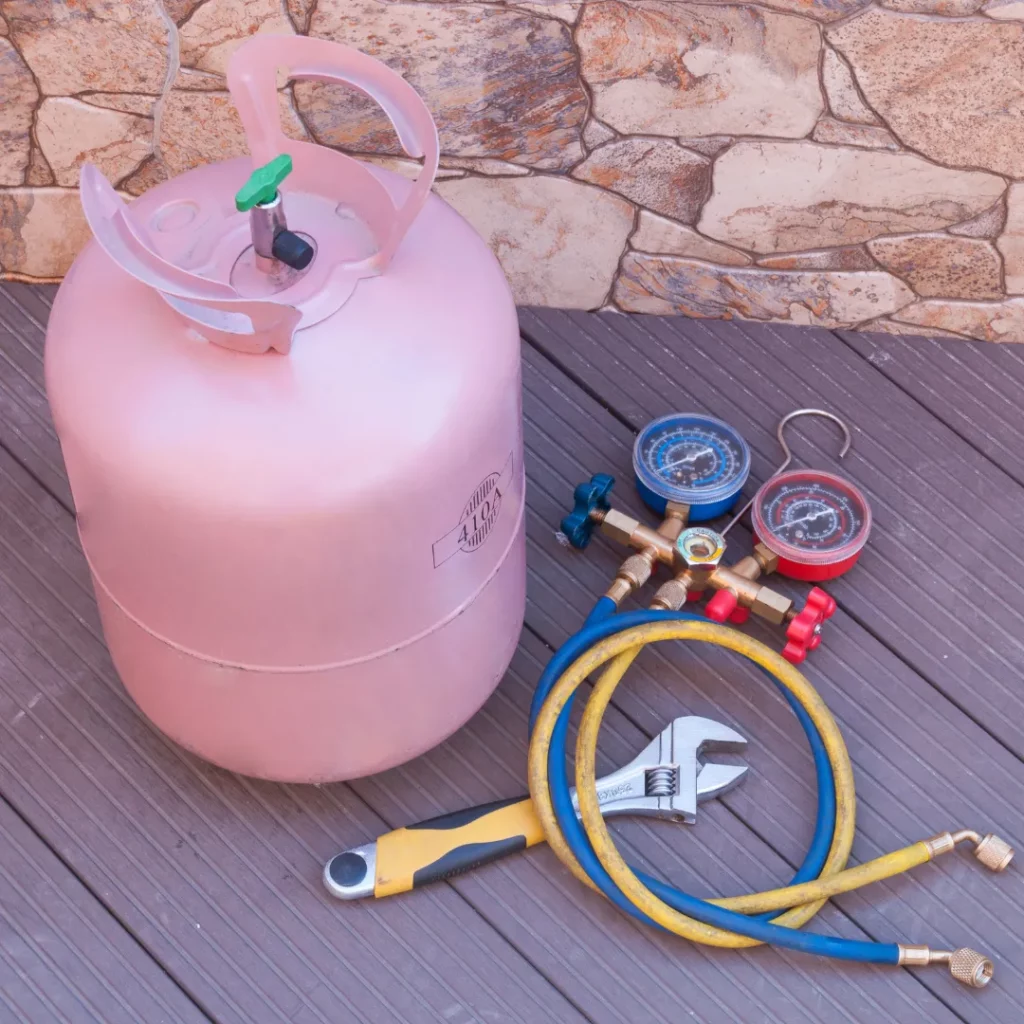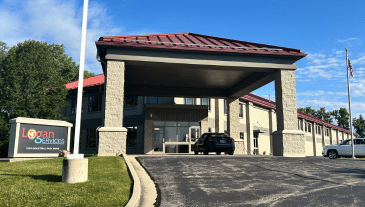R410A is a popular choice for AC systems due to its energy-efficient properties. If you’re considering using this refrigerant in your AC system or making the transition from R22 to R410A, there are a few important things you need to know. This article will cover the properties and applications of 410A refrigerant.
Properties of R410A Refrigerant
The R410A is a type of hydrofluorocarbon (HFC) refrigerant commonly used in AC systems, heat pumps, and commercial HVAC equipment. It was developed as an environmentally friendly alternative to older freon refrigerants like R-22. It has several benefits over traditional freon refrigerants, including a lower risk of ozone depletion and better energy efficiency.
Chemical composition and environmental safety
R410A is a mixture of two HFC compounds: difluoromethane (CH2F2) and pentafluoroethane (CHF2CF3). These compounds are non-ozone depleting, which means they have less potential to harm the Earth’s ozone layer compared to legacy AC refrigerants like R-22.
Many manufacturers, including Trane and Lennox dealers, have previously phased out older refrigerants in favor of R410A. This switch has led to a decrease in ozone-depleting substances released into the atmosphere. Additionally, R410A is said to have a lower Global Warming Potential (GWP) compared to other HFC refrigerants, making it a more environmentally-friendly choice.
Operating pressure
R410A operates at a higher pressure than older refrigerants, which allows it to absorb and release more heat. This higher operating pressure contributes to its increased energy efficiency compared to legacy AC refrigerants like R-22. HVAC equipment designed for R410A, such as air conditioners, must be specifically built to handle these higher pressures, ensuring optimal performance and safety.
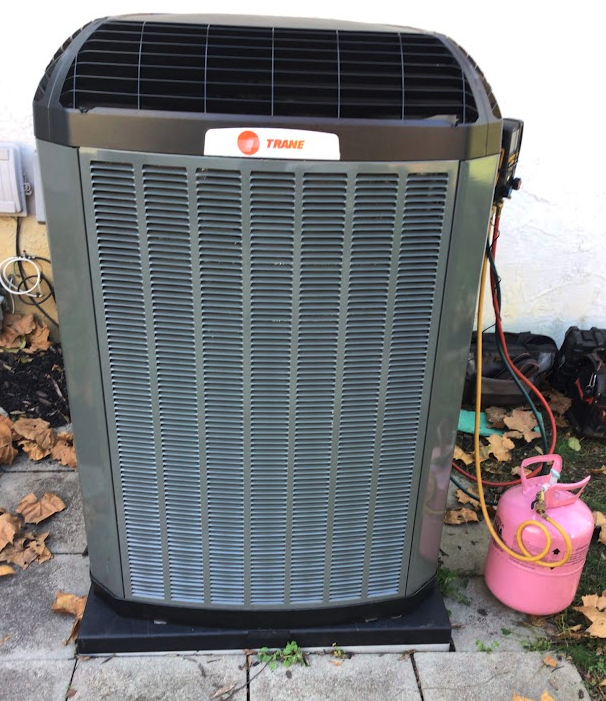
Efficiency and performance
R410A has been shown to provide better efficiency and performance in AC systems compared to older refrigerants like R-22. It has a higher cooling capacity, allowing for smaller, more efficient systems that save energy and reduce electricity bills. Additionally, R410A is less susceptible to temperature glide, which means it maintains a more consistent temperature throughout the cooling process. This leads to better temperature control and comfort for users.
Applications of R410A Refrigerant
Since its introduction in the market, R410A has become an integral part of various residential, commercial, and industrial applications due to its superior properties and environmental benefits.
Residential air conditioning systems
Many residential AC systems that have been manufactured since around 2010 use R410A as their primary refrigerant. Due to regulations banning R-22 freon production in 2020, 410a became the standard refrigerant used in residential cooling systems. Most recently, 410a is now starting to be phased out due to more efficient and eco-friendly refrigerants being used.
Commercial air conditioning systems
In commercial settings, R410A is widely used in central AC systems, rooftop units, and split-type air conditioning units. Commercial HVAC contractors working on large-scale projects often prefer to use R410A due to its reliable performance, high efficiency, and lower environmental impact.
Businesses can also use R410A-based air conditioning systems in their commercial buildings, such as wall-mounted or ceiling-mounted units, providing comfort to their employees, customers, and visitors.
Heat pumps
R410A is also used in heat pumps for residential and commercial applications. Heat pumps provide both heating and cooling by transferring heat from one area to another, making them an energy-efficient option. A heat pump system that uses R410A is more likely to provide higher efficiency and better performance compared to a system that uses older refrigerants.
Proper maintenance is crucial to ensure optimal performance and efficiency of R410A-based heat pump systems.
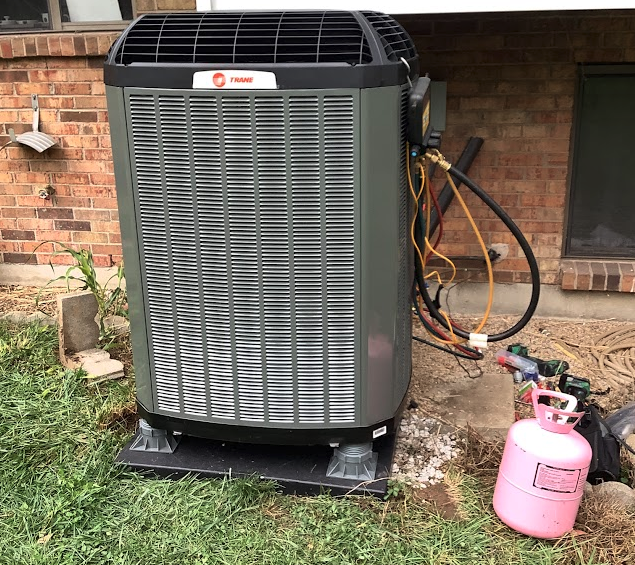
The importance of transitioning to R410A Refrigerant
Transitioning to R410A in your new HVAC system is crucial due to its numerous benefits. These advantages include the following:
– Better energy efficiency of AC systems
– Reduced greenhouse gas emissions and a decreased carbon footprint
– Compliance with environmental regulations for commercial HVAC systems
– Increased life expectancy for ac repair parts and other system components
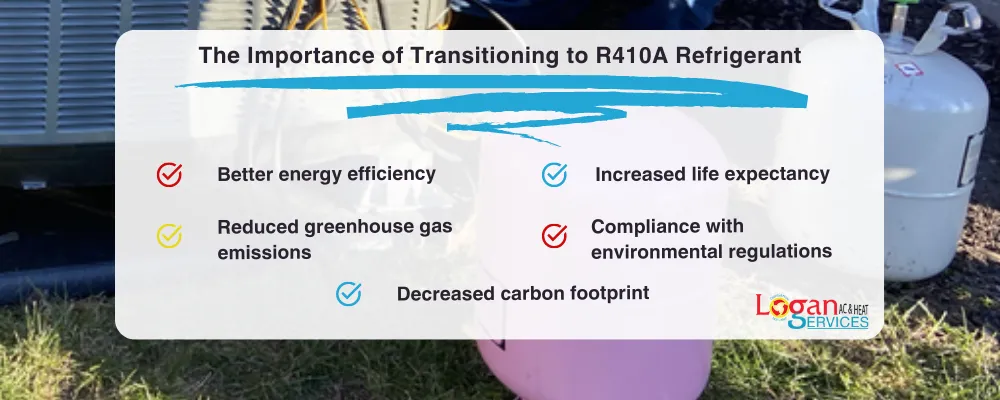
Long-term savings and environmental impact
Investing in the replacement process to the most up to date refrigerant can have the potential to yield both economical and environmental benefits in the long run. Having an HVAC system that uses R410A can lead to lower energy consumption, resulting in reduced utility bills and lower greenhouse gas emissions. This transition also reduces reliance on harmful R22 refrigerants, in turn helping to protect the environment and improve indoor air quality.
FAQs R410A Refrigerant
Can R410A be used in R22 systems?
No. Mixing R410A with R22 could lead to system failure, as these refrigerants have different chemical compositions and operating pressures. Some companies may offer retrofitting your ac with 410a, but it’s not recommended due to the cost of this service vs the cost of a new system altogether.
Can I retrofit my R22 system with 410A?
While some companies may offer retrofitting with new refrigerant, most professionals in the HVAC industry would agree that the cost to perform this service will not be worth it in comparison to what it would cost to replace the system with 410A manufactured equipment. If you choose to retrofit, it should only be done by licensed professionals to ensure proper handling of refrigerants and correct ac installation of replacement components.
How can I ensure my 410A HVAC system runs properly?
Regular maintenance, including inspection of the mechanical components, checking pressure gauge readings, and cleaning key system parts can help maintain the efficiency and lifespan of your HVAC system.

